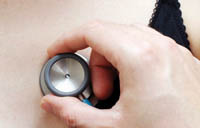Lung Cancer
Diagnosis Doesn’t Have to Be a Death Sentence
 Dominica McCants, 58, developed a bad cough at the end of March 2006. She’d had pneumonia before and knew something wasn’t right. She went to an after-hours facility where they took an X-ray, but they couldn’t tell if it was pneumonia or not. She followed up with her primary care physician who took another X-ray and sent her to East Jefferson General Hospital for further tests.
Dominica McCants, 58, developed a bad cough at the end of March 2006. She’d had pneumonia before and knew something wasn’t right. She went to an after-hours facility where they took an X-ray, but they couldn’t tell if it was pneumonia or not. She followed up with her primary care physician who took another X-ray and sent her to East Jefferson General Hospital for further tests.
Dr. Ricardo Febry, an internist at EJGH, told her that he didn’t think it was pneumonia; it looked like cancer. He referred her to Dr. Jayne Gurtler, an M.D. Anderson Physicians Network credentialed oncologist/hematologist, who did a CAT Scan, along with a lung biopsy. She received the call on April 13, 2006. She had lung cancer—stage IV bronchoalveolar cell carcinoma in both lungs. Only 30% of those with stage IV lung cancer make it a year from diagnosis; 10% make it to two years. The odds were not in Dominica’s favor.
Even though breast cancer is the number one cancer diagnosis in women, lung cancer is actually the leading cause of cancer death in women in the United States. In 2005, the American Cancer Society estimated that more women would die from lung cancer than breast, ovarian and uterine cancer combined.
Overall, men are still more likely to get lung cancer, but that gap is closing, with the continued increase in women smoking. In 2007, an estimated 114,760 men and an estimated 98,620 women will be diagnosed with lung cancer. And for reasons that are still unknown, nonsmoking women are more likely to develop lung cancer than nonsmoking men.
Dr. Gurtler began treating Dominica with Carboplatin and Toxal, drugs that were approved individually but were experimental in combination. She agreed to participate in the clinical trial, and her tumors started shrinking almost immediately. However, her energy was completely sapped during treatment, and it was difficult for her to get out of bed some days. She even had to have a blood transfusion due to her very low white- and red-blood-cell count. When her feet started to go numb, Dr. Gurtler recommended a break from the chemotherapy. When they were ready to resume treatment, bad news struck—the tumor had grown.
Dr. Gurtler decided on a new combination of drugs, Tarseva and Avastin, and resumed Dominica’s treatment in November 2006. By January 2007, no cancer could be found, and today she’s been cancer-free for almost two years. “Dr. Gurtler said she’d never seen it go away so fast. She was dancing around her office she was so happy,” says Dominica. “She calls me her star patient.”
Dominica says that one of the worst parts of having cancer is “the uncertainty of not knowing from month to month if it’s going to come back.” At the beginning, she was tested every six weeks; now she is tested every three months. But it’s tough to wait for the results each time. “There are so many things that are difficult. The side effects, losing your hair. I had gorgeous hair. The lady at the beauty shop used to say how much she loved to work on my hair. Now I wear a wig. It may seem silly, but it’s hard.”
Dominica appreciates the little things more now. “You’re more aware of things. You hear things clearer, see things clearer. You notice the birds outside your window. You see things differently.” As a cancer patient, Dominica felt no one could understand what she was going through, except for those who had gone through it themselves. “My husband is very kind, very considerate. But only someone who’s gone through it can understand what you’re going through.”
Dominica is ever thankful for the support of her friends and family, including her husband of 32 years, Junius III, and her children Michael, Brian and Kristin. “Family support is so important. My whole family has been great, that support is the best.”
“Sometimes you just get mad that the others around you are healthy. Someone complains about a headache and you think, ‘I wish I just had a headache.’ You sympathize with their problems, but they don’t know what you are experiencing unless they’ve had cancer.”
Dominica has moved back to Baton Rouge, where she lived before her diagnosis, but she still receives checkups at East Jefferson. “I live in Baton Rouge, but I come back here. Everyone at East Jefferson was so helpful. The girls in the CAT scan department are just so nice.” Things are still tough for Dominica, as she suffers the side effects of her continued use of Tarseva and Avastin, which she takes to keep the cancer at bay.
Dominica offers this advice to someone who has just received a cancer diagnosis: “The best thing you can do is make sure you have a good doctor, a doctor you believe in. And don’t give up. If the first treatment doesn’t work, there’s another one behind it. Don’t lose hope. Take each day one at a time; you’re still here. That’s what I do.”
